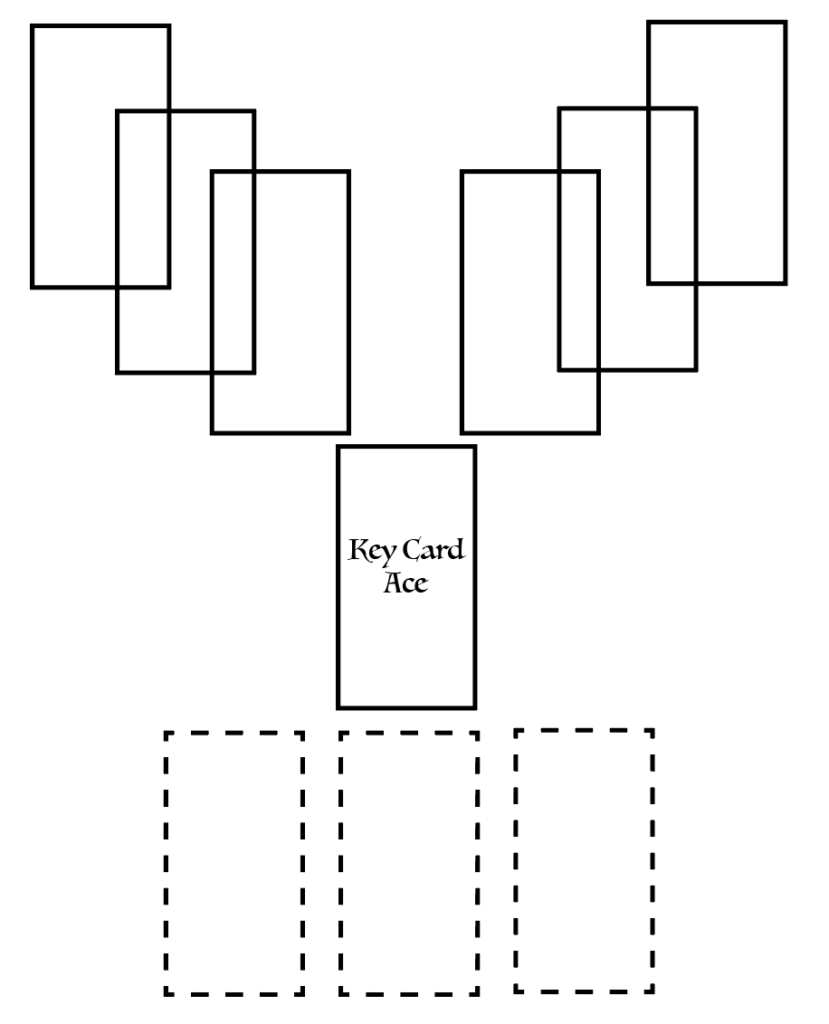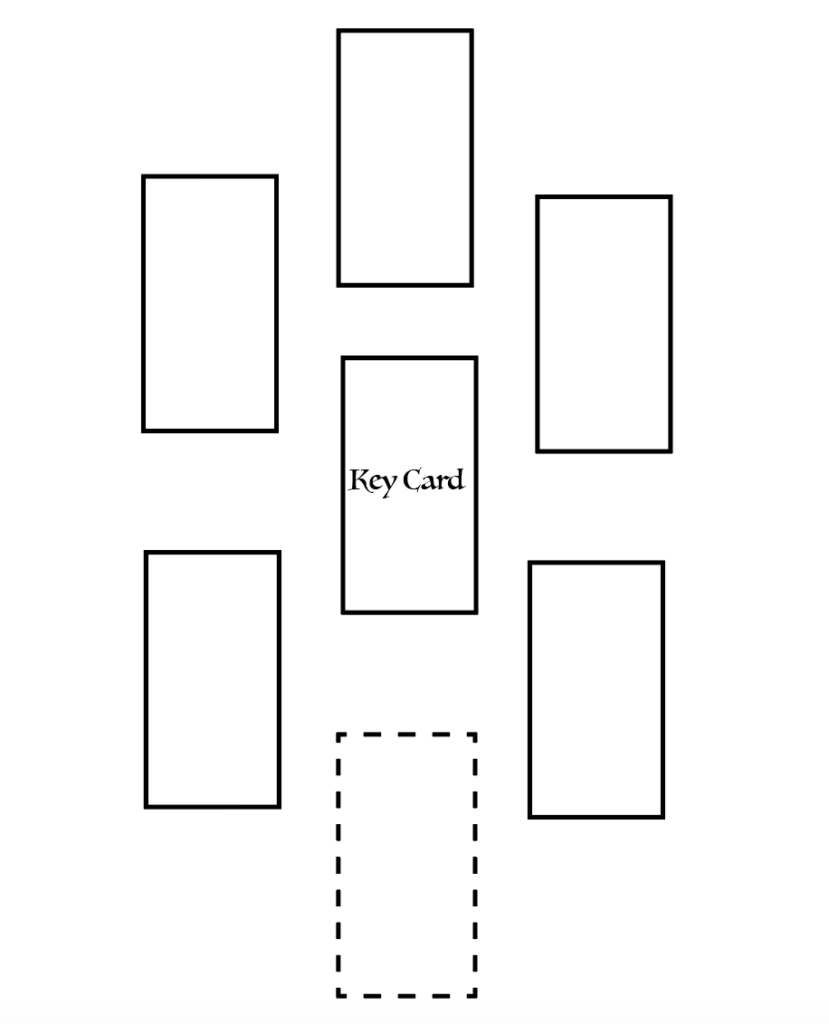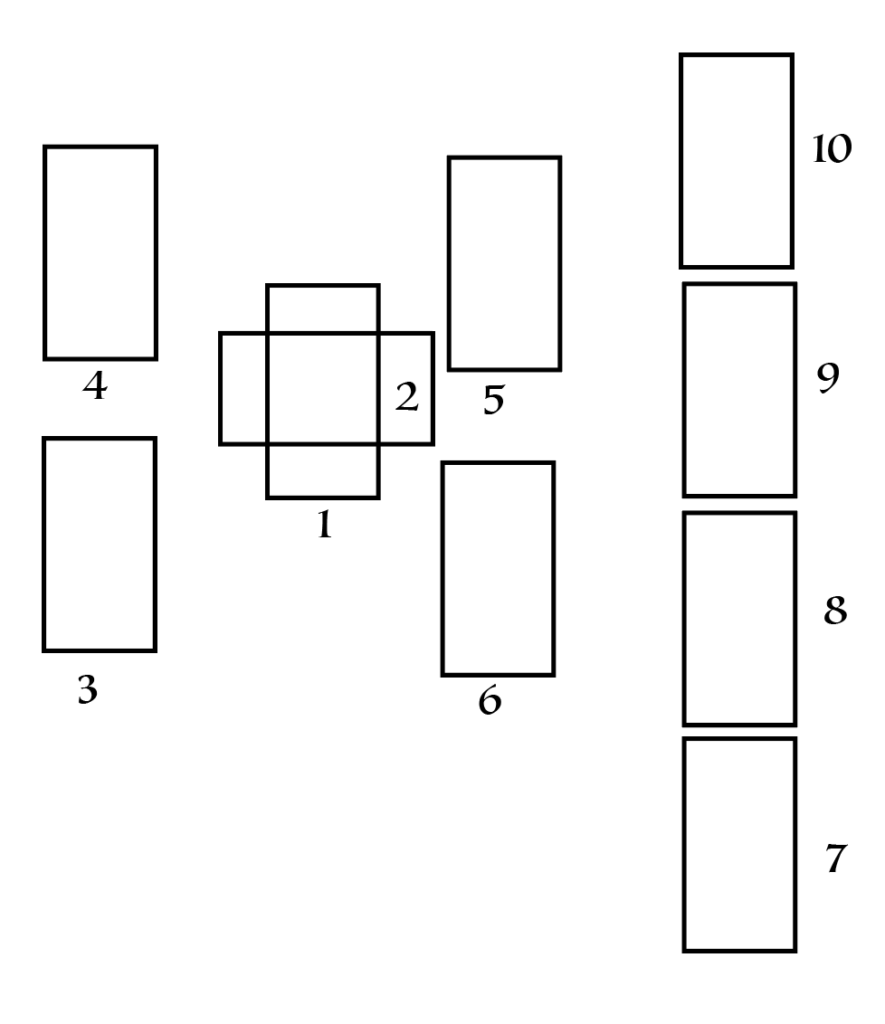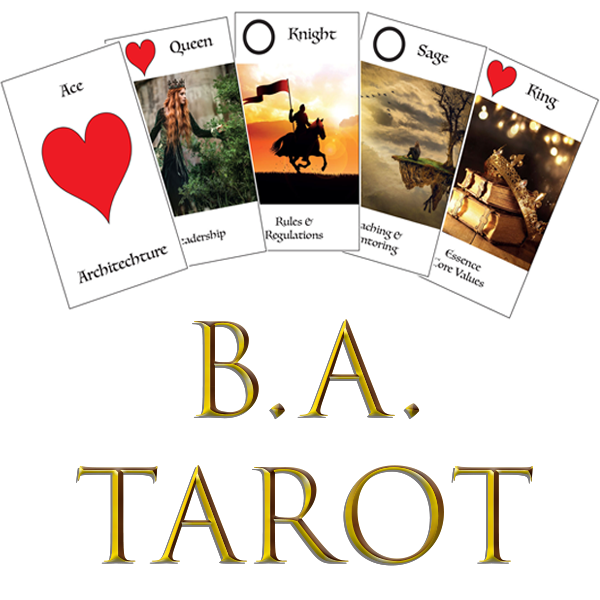
Techniques
This page describes some traditional tarot layouts and processes. The cards are not restricted to these layouts and techniques you can use whatever layout or technique you see fit.
I often simply lay out all the Aces and then just go through the cards one by one documenting comments and actions based on the subjects presented. I have used the cards within scenarios to question the subjects based on the scenario presented.
Feel free to play and try different things out – Please send me anything that you find useful and send me pictures of you using the cards.
7 card Horseshoe Reading
To consider a particular aspect:  This layout can be used to consider each suit in turn. The positioning keeps 6 aspects in view with the subject. Each card is positioned in a way that connects to different aspects of the problem or situation at hand. During the discussion key findings and cards that represent the highest priority can be moved to the left and the right of the Key Card for focus. If relevant the 3 holy trinity cards can be placed below. (see dotted line). Once each of the suits have been analysed the key cards can be put aside and analysed at a later date.
This layout can be used to consider each suit in turn. The positioning keeps 6 aspects in view with the subject. Each card is positioned in a way that connects to different aspects of the problem or situation at hand. During the discussion key findings and cards that represent the highest priority can be moved to the left and the right of the Key Card for focus. If relevant the 3 holy trinity cards can be placed below. (see dotted line). Once each of the suits have been analysed the key cards can be put aside and analysed at a later date.
For a higher level strategic analysis instead of each suit, each ace can be positioned in the V which gives an holistic view of the organisation.
The principal cards can then be placed below in the dotted area for discussion. Some times I reverse the V when sitting opposite the subject so that they can see the cards well.
The Pentagram Spread
To consider 5 (or 6) functional considerations:  The 4 Elements (represent Earth, Air, Fire and Water) are usually placed left and right – We don’t have elemental cards so choose 4 principal aspects of the subject. The central Key card represents the focus of the situation. The top and bottom cards are influences on the key card. As an alternative the left hand side can represent the”The Past” and the Right hand side ” The Future”.
The 4 Elements (represent Earth, Air, Fire and Water) are usually placed left and right – We don’t have elemental cards so choose 4 principal aspects of the subject. The central Key card represents the focus of the situation. The top and bottom cards are influences on the key card. As an alternative the left hand side can represent the”The Past” and the Right hand side ” The Future”.
The layout as a star the 5 pointed pentagram (or optional 6 points) can be used to reflect the key card with 5 or 6 influences upon that central subject.
I have also used this layout as an alternative method. Pile up each of the suits on each star point, starting with the ace and work through all the cards (Castle, King, Queen, Joker, Knight, Sage) to identify areas of strength/ weakness or to get an holistic view of the organisation.
The Celtic Cross
This layout and method is more complex and may or may not work for certain situations as it relies on the “chance” element of random card delivery from the pack. This results in random indications that may not be relevant-You may need to choose the cards you use in advance.
Shuffle the pack and give it to the subject to cut or shuffle and tell them to choose 10 cards from the deck. ( you can include the W’s and Trinity i fyou wish)
- Card 1: The Querent. This card indicates the person or topic in question
- Card 2: The Situation. This card indicates the situation at hand or the potential situation
- Card 3: The Foundation. This card indicates factors that are behind the Querent. (Often historical)
- Card 4: The Recent Past. This card indicates events and influences that are more recent.
- Card 5: Short-Term Outlook. This card indicates events that are likely to take place in the near future – generally within the next few months
- Card 6: Present State of the Problem. This card indicates the “as is” situation and can be used to discuss the “to be” situation.
- Card 7: Outside Influences This card indicates external influences that may have an effect on the desired outcome.
- Card 8: Internal Influences. Inner feelings have a strong influence on our actions and behaviours. Look at Card 1, and compare the two–are there contrasts and conflicts between them?
- Card 9: Hopes and Fears. This card represents the Risks and constraints to the situation
- Card 10: Long-Term Outcome. This card reveals the likely long-term resolution of the issue.
If you like randomness and a bit of a wild card approach to your interviews or workshops use this you may be surprised what it elicits – The subject will at least feel they have had an influence on the outcome. However it may produce a random result. If this is the case ask the subject to chose a replacement from the remaining cards. OR you can choose 10 appropriate cards from the deck for the situation turn them face down and then turn them over to reveal the issues that you want to discuss with the subject.
There are many other ways that the cards can be used – SNAP is also a good one 🙂
